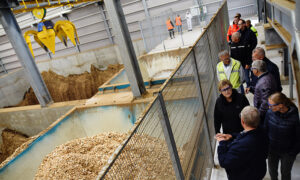 With a new facility running on wood chips, the Dupont company’s food factory located in Grindsted, Denmark, allows them to cease the use of coal, and direct surplus heat into district heating pipes. A textbook example of efficient energy production, says the Danish District Heating Association.
With a new facility running on wood chips, the Dupont company’s food factory located in Grindsted, Denmark, allows them to cease the use of coal, and direct surplus heat into district heating pipes. A textbook example of efficient energy production, says the Danish District Heating Association.
Last week, the food business DuPont Nutrition Biosciences in Grindsted inaugurated a new facility running on wood chips, thereby replacing 18,000 tons of coal and paving the way for utilisation of surplus heat by the city’s 3,700 heating customers.
According to the Danish District Heating Association, this is a textbook example of how industry and heat supply can go hand in hand for the benefit of consumers and the environment.
-The result of the collaboration between DuPont and Grindsted Electricity and Heating Plant is an excellent example of how the different interests of two companies can meet and create more value for them both, says the director of the Danish District Heating Association, Kim Mortensen, who also participated in the inauguration at the DuPont factory in Grindsted.
DuPont’s wood chip facility will reduce their annual CO2 emissions by 64,000 tons – equivalent to the CO2 emitted by 27,000 cars. The wood chips are supplied by HedeDanmark, who will ensure that the wood comes from sustainable logging.
Surplus heat for households
DuPont produces food ingredients through an energy intensive process, with a heat consumption equivalent to that of more than 10,000 households combined. The surplus heat supplies half of the district heating that the 3,700 consumers in Grindsted receive from Grindsted Electricity and Heating Plant.
-There is great potential in surplus heat from both the industry and data centres that district heating companies would like to convert into heating for households. Since the surplus heat comes from a range of different sources, each district heating company has to think creatively in order to find a solution that benefits from this heat, says Kim Mortensen and continues:
-Therefore, there is reason to be pleased about the solution in Grindsted that allows the surplus heat to be directed into the district heating pipes rather than into the thin air.
In the government’s latest analysis from March this year regarding surplus heat, it was estimated that the combined potential of surplus heat amounts to around 12.5 PJ, compared to the 5 PJ that are utilised today. This estimate does not include the potential from data centres that was recently announced.
The Danish Minister for Energy, Utilities and Climate, Lars Chr. Lilleholt held a speech at the inauguration at DuPont in Grindsted on Monday the 25th of September.
Source: State of Green / Dansk Fjernvarme